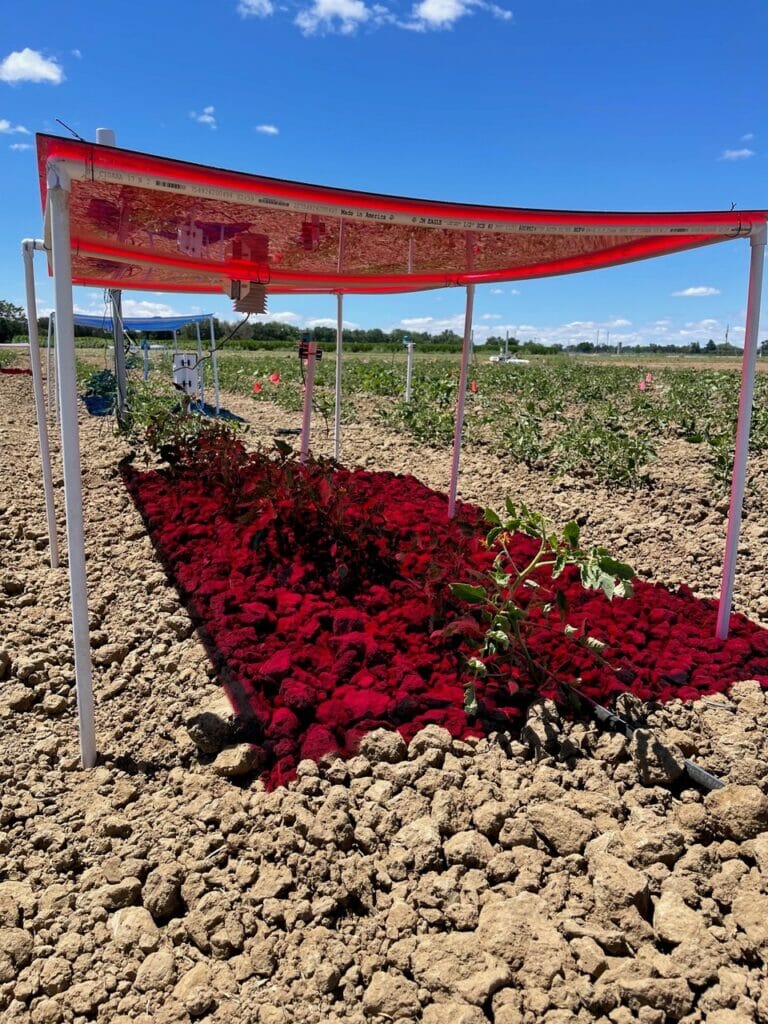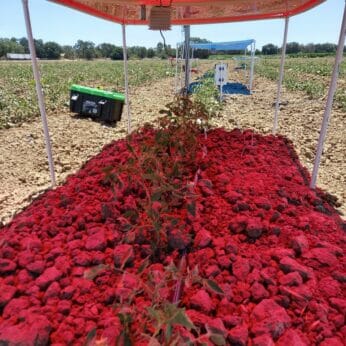Researchers harness sunlight to harvest energy and food together, utilizing the full spectrum of light to improve outputs.

Arable land is at an all-time premium. Since the last ice age, humans have cleared one-third of the earth’s forests and two-thirds of its wild grasslands, much of it for agriculture. And as the world population—8 billion as of last November—continues to expand, there’s ever-increasing pressure on farmland to produce not only more food but clean energy as well.
In places such as Yakima, Washington, it’s created competition for space as land-hungry solar arrays gobble up available fields. Last month, the state’s Energy Facility Site Evaluation Council approved plans to cover 1,700 acres of agricultural land with photovoltaic (PV) panels, brushing aside the county’s moratorium on solar projects and fueling community concerns over the long-term impacts of losing cropland.
A recent study from the University of California, Davis, however, shows how farmers may soon be able to harvest crops and energy together, on common ground. Researchers concluded that bands within the visible light spectrum can be filtered and harnessed separately—blue lightwaves to generate solar power and red lightwaves to grow fruits and vegetables—to make maximum use of farmland, all while lowering heat stress and reducing crop waste.
“Why does [agriculture] have to be a zero-sum game if we can optimize the land for both?” asks Majdi Abou Najm, an associate professor in the Department of Land, Air and Water Resources at UC Davis and an Institute of the Environment fellow, who co-authored the paper.
Photons, or the particles that make up light, have different properties, he explains: Blue ones have higher energy than their red counterparts, resulting in light with shorter wavelength and higher frequency. While that gives blue light the jolt needed to generate power, the extra pulsing also results in higher temperatures.
“From a plant perspective, red photons are the efficient ones,” says Abou Najm. “They don’t make the plant feel hot.”
Through computer modeling, Abou Najm and lead author Matteo Camporese, an associate professor in the Department of Civil, Environmental and Architectural Engineering at the University of Padova, found that applying red lightwaves to plants increases photosynthesis and carbon assimilation—the process by which they metabolize carbon dioxide into organic compounds—while lowering transpiration. In other words, under the cooler spectrum, “crops can get the same amount of CO2 using less water,” he says.
While their research was inspired by hydroponic light applications used in indoor farming systems, “those come at a high energy cost,” says Abou Najim. “We decided to use sunlight as our input.”
One of the main goals of the study, says Abou Najim, is “to motivate the industry to create a new generation of solar panels.” Camporese sees potential in organic solar cells, which, unlike the shiny, metallic, silicon-based surfaces, are derived from carbon-based compounds. Thin and translucent, the cells are applied like a film onto various surfaces, including glass. This technology could be used to develop photo-selective PV panels that filter blue light to generate power, he says, while passing the red spectrum to crops planted directly below.

Tomatoes grown under the light-filtering solar panels. Photography courtesy of Majdi Abou Najim
The growing field of agrivoltaics, wherein land is used for both food production and energy generation, has, in fact, made land use more efficient by interspersing conventional solar arrays between rows of crops. (Solar grazing is a variation where livestock pasture in between the arrays.) The angled panels shade leafy vegetables and heat-sensitive fruits from the day’s most intense rays; the plants, meanwhile, transpire moisture and lower the temperature beneath the heat-sensitive cells, thereby improving their performance.
However, the plants grown through agrivoltaics are grown in partial shade, and “less light typically means less yield,” says Camporese. This effectively sets a limit on the density of solar panels and plantings on co-generation farms. But translucent arrays would allow for full field coverage of both, he notes, maximizing land use and giving a big bump to per-acre productivity.
Last May, the researchers conducted a limited field study of photo-selective cropping at the UC Davis Agricultural Experiment Station. The team planted processing tomatoes—a common Sacramento Valley crop—on small, equal-sized plots, one canopied with a photo-selective red filter, another with blue and a third left uncovered as a control.
After approximately four months, including a record heatwave in early September, the two filtered plots each yielded about a third less than the uncovered one. Yet when sorted for quality—ripe, unripe or “bad”—the control plot accounted for twice the amount of rotten tomatoes. “So the filters helped in reducing heat stress,” says Abou Najm, and “cut [crop] wastage by more than half.”
Add energy generation on top and the net gain would more than compensate for the diminished harvest, he says. By co-locating crops and solar generation, “100 percent becomes a very low number when you can get 120- or 140-percent yields.”
And for countries and regions facing a tight squeeze on farmland, that makes increased productivity even more valuable, especially given that generating clean energy requires 10 times more land per unit of power than fossil fuels.
Abou Najm also sees the canopied approach as a way for farmers to build climate resilience. Filtering the sun helps the soil retain moisture and shield farmworkers from harsh rays, while lower transpiration means less water is needed for crops. And by generating their own power, farmers could offset rising energy costs and nudge the industry towards embracing electric equipment and vehicles, he adds.
“By 2050, we’ll have [an additional] two billion people on this planet, and we’ll need 60 percent more food, 40 percent more water and 50 percent more energy” than is currently produced, says Abou Najm. Research needs to occur on a transformative level in order to meet those ballooning needs.
By maximizing the solar spectrum, “we’re optimizing an endlessly sustainable resource,” he adds. “If a technology kicks in that can develop these panels, then the sky is the limit on how optimized we can be.”
Very interesting research! I would love to see the actual papers written at UC Davis to help clarify how to calculate a proper return on investment “theory”. I realize though that these solar panels still need to be developed.
Very encouraging move. Farmers particularly in tropical regions can hope for better living through such studies and results when implemented..
I would like to do some research of these panels in Maine. Droughts are more common, energy prices are climbing, climate crisis is in full swing, as the article states, the Sun is an “endlessly sustainable source”.
There was no PV used in the experiment. Rather, they just used colored filters. It’s a long stretch to develop transparent pv cells.
Great forward thinking! But would this be viable on farms that rely on rain, or even overhead irrigation? I see the experiment had drip irrigation. How would water get past panels to the plants?
This is incredible! I wonder how the red light affects bees foraging on flowering crops, and performance of honey bee colonies in hives? I do not know the answer. Seems like this panel may be useful in extreme hot climates to minimize heat stress on hives of honey bees, but will the bees leave the hives to forage?
What solar panels filter the blue to generate energy and pass the red?
At http://www.lleaf.com we shift the spectrum of sunlight to increase the growth rate of plants (20% average) by spectrum selective absorption of green light and producing a net increase in red light.
Naomi, we have developed and patented fabrics that go a step further and convert sunlight energy (UV to visible spectrum) and emit red light. Our use is in human and animal clothing for red light driven therapeutic wellness, shade cooling and UV protection, but we have always thought these textiles should be used to cover crops. This research proves it. What do you think? See lumiton.com.
We can do this at our organic farm in the Finger Lakes Region of New York State with our Colleagues at Clarkson University, Cornell University, Alfred University, and SUNY College of Environmental Science and Forestry. The soybeans and milkweed will be replacements and improvements over what is now made from petroleum.